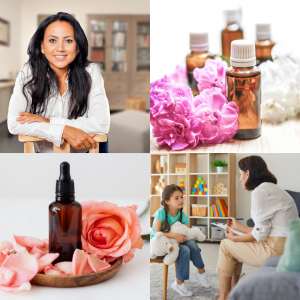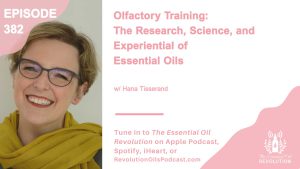(Listen to the Full Podcast Here.)
Appreciating the Power of Smell
Due to the recent pandemic, we have all come to better appreciate our noses. This is because many people lost their ability to smell. In fact, statistics show about 26% of people who had the infection for longer than four weeks experienced an absence of olfactory function. Of the overall population in 2021, it was estimated that about 3% suffer from anosmia, the complete loss of smell, or hyposomia (minimal smell).
Thankfully, there is hope for those who have olfaction dysfunction. In the latest episode of the Essential Oil Revolution, Hana Tisserand joins us to discuss the topic of olfactory training, a technique used to recover smell. She also highlights the important work that she is doing at the Tisserand Institute, a global leader in online science-based essential oils education.
In this episode, you will come to appreciate Hana’s incredible ability to synthesize complex studies and provide detailed and scientific information in a manner that is concise, accurate, comprehensive, and understandable.
What You Will Learn During the Show:
- The history of the Tisserand Institute and why it transformed from in-person integrative practitioner training in aromatherapy to online holistic training in essential oils.
- How Hana’s unique background influenced her to be an expert in essential oils. This includes her growing up in the Czech Republic. There, integrative, conventional, and natural approaches co-exist in pharmacies side-by-side. You’ll also discover how this knowledge, and her previous profession led her to meet Robert Tisserand.
- The importance of smell as a chemosensory experience. For example, it alerts us to danger, influences our taste, stimulates memory, and determines how we interact with the world on a sensory and hedonistic basis.
- What component found in essential oils are the most communicated “language” in the world. These molecules are shared by every creature on the planet, from single-celled organisms to mammals.
- How essential oils constituents can still impact our biochemistry and physiology, even if you lose your ability to smell.
- The concept of olfactory training and how it works.
- Why specific essential oils or the constituents found within them, phenylethanol (rosy), 1,8-cineole (eucalyptus), citronellal (lemony), and eugenol (clove), are used in smell training. We also discuss if essential oils are more powerful than the single constituents,
- Why olfactory training works the best for those with infections and an intact, functioning trigeminal nerve.
- Why the aim of the Tisserand Institute is to provide education and information that is accurate, safe, and accessible to all essential oil users vs. preparing one for aromatherapist certification.
- One thing Hana does for self-care daily. (Hint it has to do with her love of aromas and hot beverages.)
- The one things Hana feels we should ditch and replace with instead to be healthier.
- Hana’s favorite essential oils hack.
Click here to listen in on the latest episode and access the show notes.
Click here to get more resources and details on the show and Hana Tisserand in my article.
Naturopathic Medicine and Holistic Resources for Hormone, Digestive, and Mood Support

- Stay Connected! Sign-up for my free weekly newsletter.
- Free resources and more education on essential oils and mind-body wellness are available to you here.
- Tools for coping with isolation and separation.
- Learn about my community membership program that provides full access to my essential oils database, essential oils course, Q&As, and exclusive content.
- The Essential Oil Revolution podcast
Disclaimer: This material is for information purposes only and is not intended to diagnose, treat, or prescribe for any illness. You should check with your doctor regarding implementing any new strategies into your wellness regime. These statements have not been evaluated by the FDA.
This information is applicable ONLY for therapeutic quality essential oils. This information DOES NOT apply to essential oils that have not been tested for purity and standardized constituents. There is no quality control in the United States, and oils labeled as “100% pure” need only to contain 5% of the actual oil. The rest of the bottle can be filled with fillers and sometimes toxic ingredients that can irritate the skin. The studies are not based solely on a specific brand of an essential oil, unless stated. Please read the full study for more information.




